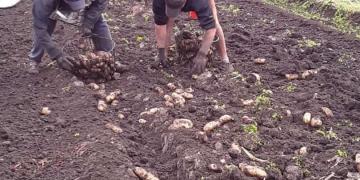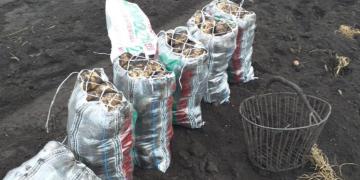EEUU: Idaho grower pleased with no till spuds
An Eastern Idaho farmer has experimented with no-till potatoes.

ST. ANTHONY, Idaho — Jeff Parkinson made a spur-of-the-moment decision last spring to conduct a bold experiment with a couple of acres of potatoes.
Based on the results, Parkinson is encouraged that no-till potato production can work in Eastern Idaho, and he plans to continue refining his system.
“I’ve been doing the no-till for a couple of years now for wheat,” Parkinson said. “I thought, ‘Why wouldn’t it work for potatoes?’”
Parkinson, who farms on the Egin Bench between Rexburg and St. Anthony, has highly erodible sandy-loam soil.
“Wind erosion is a big problem for us here. That’s why I went into no-till,” Parkinson said.
Within a 35-acre quarter of a pivot, Parkinson cut his wheat short at harvest, leaving residue and a couple of inches of stubble. After harvest, using his no-till grain drill, he direct-seeded radish into the stubble as a cover crop, planted solely for soil-health benefits. By the next spring, the cover crop had broken down.
Parkinson chisel-plowed the majority of the field prior to planting potatoes, but he left 2.5 acres undisturbed, applying a generic version of Sencor herbicide to control grasses and a few broadleaf weeds.
Getting fertilizer to his potato seed required a bit of ingenuity. Parkinson modified an older-model V-ripper, adjusting the shank spacing to loosen soil between rows for root growth, and adding another tool bar and smaller shanks at the back, with hoses to inject bands of liquid fertilizer beside the seed pieces.
He applied the bands three weeks after planting, cutting his usual fertilizer rate by 15 percent thanks to the precise placement.
Yields were down about 15 hundredweight per acre in Parkinson’s no-till spud plot, which he considers acceptable, given that the no-till section was on the outer edge of the field and receives less water and fertilizer from the pivot. Furthermore, the no-till plot didn’t receive the dry starter fertilizer that was broadcast throughout the rest of the field.
“I felt like all the years, guys have worked their soil way too much and made too many trips through their fields, using too many pieces of equipment,” Parkinson said.
He’ll put his experiment on hold this season, having tilled all of his fields to rid them of heavy vole populations. But he intends to resume his no-till potato trials once vole pressure subsides. Even with the slight yield decline he anticipates, he expects the erosion benefits and water, fuel, fertilizer and equipment savings to make it worthwhile.
University of Idaho Extension agronomist Jeff Stark said the university conducted no-till potato trials in the 1970s in Fort Hall.
“They’d see a little decrease in yield, but they did see it was a viable program if they could put all of the pieces together properly,” Stark said, adding residue management and weed control were among the greatest challenges.
He said a few growers in the American Falls area have also dabbled in no-till spuds.
For the past six seasons, UI Extension weed specialist Don Morishita has conducted no-till sugar beet trials.
“The work with no-till beets has been very favorable,” Morishita said, adding his no-till beet yields were about 5 percent less, but the reduced inputs made up for the difference.
Morishita said the practice hasn’t been widely accepted by the beet industry, and he has no funding to continue the research this season.
Fuente: http://www.capitalpress.com/Research/20160209/idaho-grower-pleased-with-no-till-spuds







